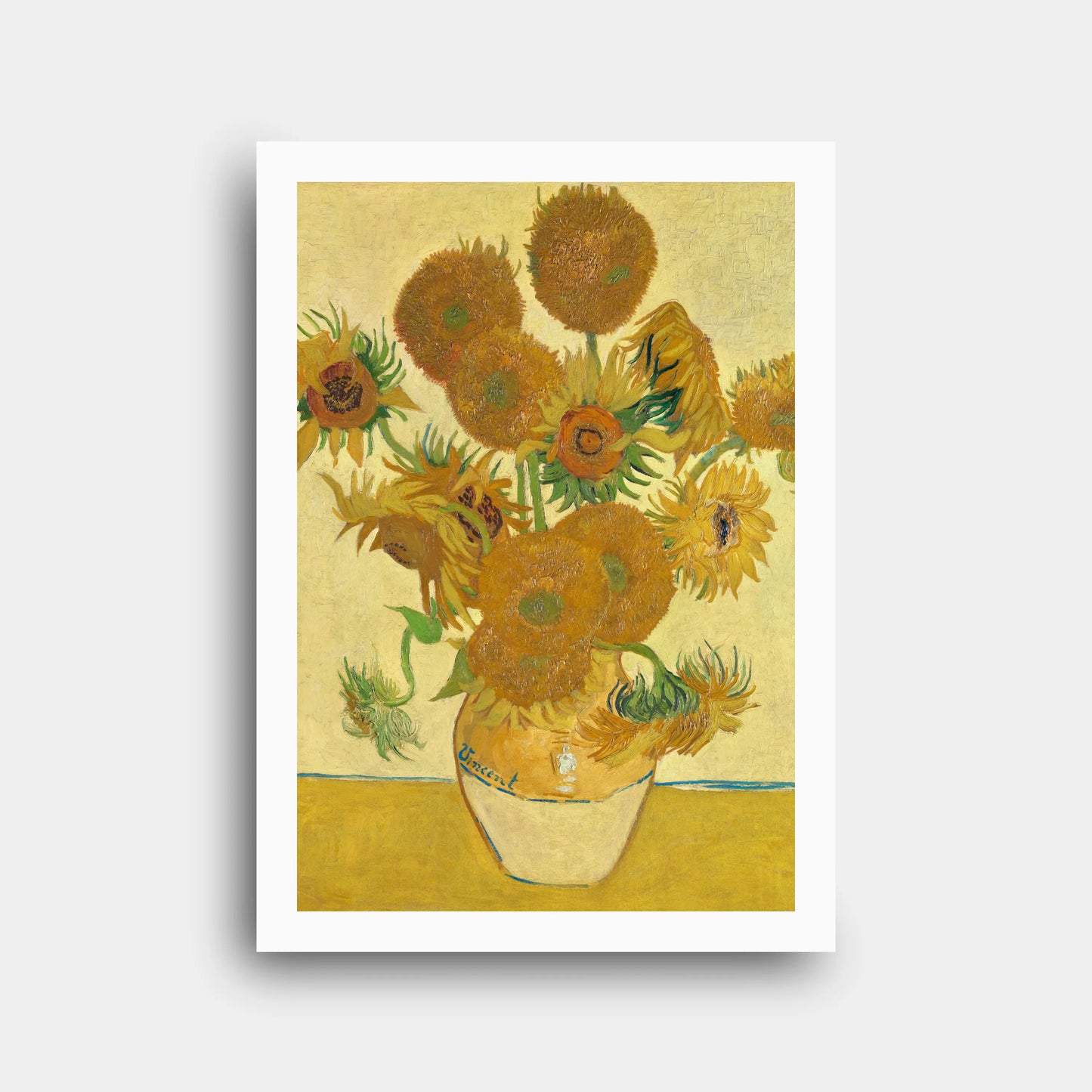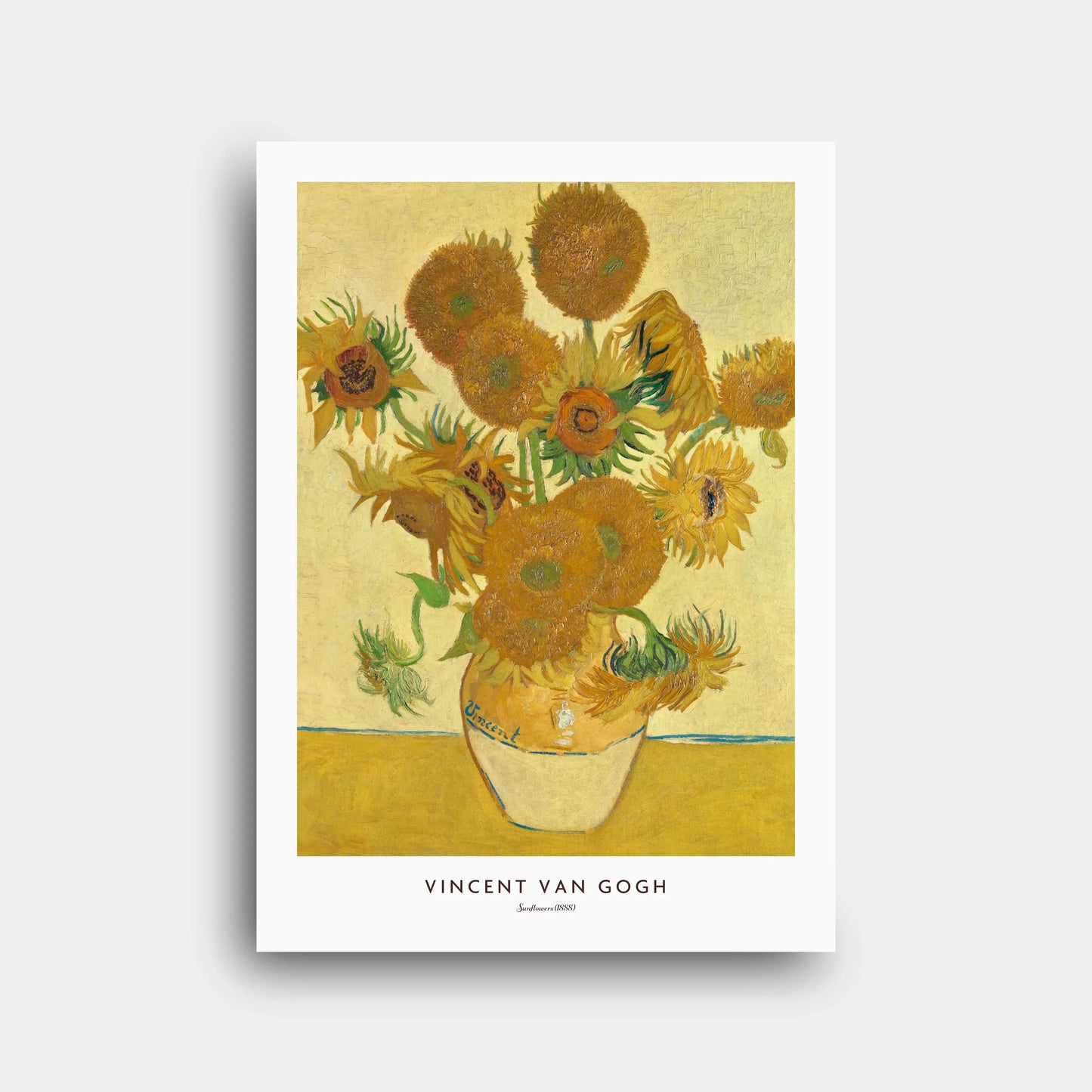Vincent van Gogh - Sunflowers (1888) - Canvas Print N192
Vincent van Gogh - Sunflowers (1888) - Canvas Print N192
Couldn't load pickup availability
Share
Paper Poster | Canvas Print | Digital File
1. Historical and Artistic Context
Vincent van Gogh’s “Sunflowers” (1888) is part of his celebrated series created in Arles, southern France. At this time, Van Gogh had left Paris to find brighter light, more vivid colors, and a space for concentrated artistic production. He planned to welcome Paul Gauguin to the Yellow House and envisioned decorating Gauguin’s room with these sunflower paintings as symbols of warmth and hospitality. Within the broader art historical context, these works mark Van Gogh’s transition from impressionist influence toward his distinctive post-impressionist style, emphasizing emotion, symbolism, and color intensity over naturalistic depiction.
2. Technical and Stylistic Analysis
The painting is notable for its restricted palette dominated by yellows, ochres, and touches of green. Van Gogh masterfully used tonal variations within this limited range to produce richness and harmony. His vigorous brushstrokes and thick impasto create dynamic textures, making the flowers seem alive with energy. The background, painted in flat yellow, eliminates depth and focuses all attention on the bouquet. This stylistic flattening recalls Japanese prints, which Van Gogh deeply admired. The asymmetrical composition, with flowers at varying stages of bloom, creates rhythm and visual tension while remaining balanced overall.
3. Symbolism and Interpretation
The sunflowers have been interpreted as symbols of light, gratitude, and artistic friendship. Van Gogh saw them as welcoming emblems for Gauguin, signifying companionship and creative collaboration. They also reflect cycles of life: some blossoms are fresh, others droop, highlighting themes of growth, decline, and mortality. Many scholars see the sunflower as a metaphor for Van Gogh himself, radiant yet fragile, always turning toward the sun in search of hope. In Christian symbolism, the flower’s orientation toward light has also been linked to spiritual devotion and renewal.
4. Technique and Materials
Van Gogh painted with oil on canvas, using coarse fabric that could hold his thick applications of paint. He worked quickly, often finishing canvases in a day, applying paint directly from the tube in some areas. Chrome yellow, cadmium yellow, and touches of green dominate the palette, though some pigments have darkened over time. His impasto technique in the flower heads adds tactile presence, while his outlines in blue around the vase and table edge provide subtle contrast. These technical choices enhanced the work’s vibrancy and immediacy, hallmarks of Van Gogh’s style in Arles.
5. Cultural Impact
“Sunflowers” has become one of the most recognized and reproduced paintings in the world, symbolizing Van Gogh himself. It has inspired countless artists, influenced modernist explorations of color, and entered popular culture on posters, merchandise, and media. The series embodies resilience, hope, and beauty, contrasting with the tragedy of Van Gogh’s life. Exhibitions of the paintings draw record audiences, while their imagery often appears in literature, music, and film as metaphors for artistic genius and vulnerability. Their enduring popularity highlights how deeply they resonate with universal human emotions.
6. Critical Reception and Scholarly Interpretations
Initially, Van Gogh’s sunflower paintings were considered unusual and bold, admired mainly within avant-garde circles. Gauguin praised them and later painted Van Gogh at work on the series. Over time, critics came to view them as masterpieces of post-impressionism, emblematic of expressive color and symbolic depth. Scholars interpret them in multiple ways: as autobiographical self-portraits, as modernized vanitas still lifes, or as meditations on mortality and renewal. Conservation studies have also deepened appreciation, revealing how pigment changes altered their appearance while underscoring Van Gogh’s experimental spirit.
7. Museum, Provenance and Exhibition History
Several versions of “Sunflowers” exist, with major examples housed in the National Gallery, London; the Van Gogh Museum, Amsterdam; the Neue Pinakothek, Munich; and the Philadelphia Museum of Art. The London version entered the National Gallery in 1924 through the Courtauld bequest. Another version was famously sold at auction in 1987 for nearly $40 million, setting a record at the time. The works have toured internationally, serving as cultural ambassadors and attracting millions of visitors. Their provenance highlights both their artistic importance and extraordinary market value.
8. Interesting Facts
1. Van Gogh painted seven still lifes of sunflowers in vases between 1888 and 1889.
2. They were created to decorate Gauguin’s room in the Yellow House.
3. Gauguin painted Van Gogh working on the series in “The Painter of Sunflowers.”
4. Van Gogh signed them “Vincent” for international recognition.
5. Chrome yellow pigments used have partially darkened with time.
6. One version set an auction record in 1987 at nearly $40 million.
7. The Munich version was hidden in a salt mine during World War II.
8. The London “Sunflowers” is a symbol of the National Gallery.
9. Scientific studies have traced pigment degradation in these works.
10. In 2022, climate activists targeted the London version in protest actions.
9. Conclusion
Van Gogh’s “Sunflowers” (1888) embodies the artist’s vision of light, friendship, and beauty. With bold color, tactile brushwork, and symbolic resonance, the painting elevates a humble flower into an icon of modern art. Its cultural impact, critical acclaim, and enduring relevance testify to Van Gogh’s genius and his ability to infuse ordinary subjects with extraordinary meaning. Today, the “Sunflowers” remain among the most beloved works of Western art, continuing to inspire and captivate audiences worldwide.











